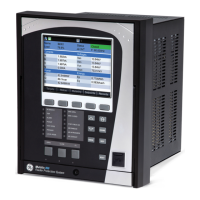4–2 850 FEEDER PROTECTION SYSTEM – INSTRUCTION MANUAL
SETPOINTS ENTRY METHODS CHAPTER 4: ABOUT SETPOINTS
Figure 4-2: Main Setpoints Screen
Setpoints Entry Methods
Before placing the relay in operation, setpoints defining system characteristics, inputs,
relay outputs, and protection settings must be entered, using one of the following
methods:
• Front panel, using the keypad and the display.
• Front USB port, connected to a portable computer running the EnerVista 8 Series
Setup software.
• Rear Ethernet (copper or fiber port connected to portable computer running the
EnerVista 8 Series Setup
software.
• Wi-Fi wireless connection to a portable computer running the EnerVista 8 Series Setup
software.
• Rear RS485 port and a SCADA system running user-written software.
Any of these methods can be used to enter the same information. A computer, however,
makes entry much easier. Files can be stored and downloaded for fast, error free entry
when a computer is used. To facilitate this process, the GE EnerVista CD with the EnerVista
8 Series Setup
software is supplied with the relay. The relay leaves the factory with
setpoints programmed to default values, and it is these values that are shown in all the
setpoint message illustrations.
At a minimum, the Setpoints > System setpoints must be entered for the system to function
correctly. To safeguard against the installation of a relay whose setpoints have not been
entered, the Out-Of-Service self-test warning is displayed. In addition, the Critical Failure
relay is de-energized. Once the relay has been programmed for the intended application,
the
Setpoints > Device > Installation > Device In Service setpoint should be changed from
“Not Ready” (the default) to “Ready”.Before putting the relay in “Ready” state, each page of
setpoint messages should be worked through, entering values either by keypad or
computer.

